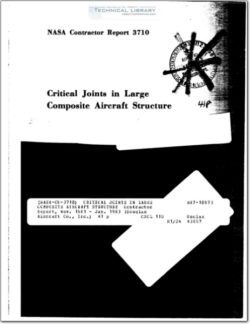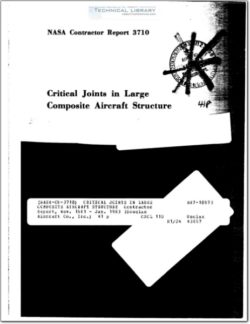NASA-CR-3710

- Version
- 287 Downloads
- 2.39 MB File Size
- 1 File Count
- May 19, 2016 Create Date
- May 19, 2016 Last Updated
Critical Joints in Large Composite Aircaft Structures

ABSTRACT
A program was conducted at Douglas Aircraft Company under NASA-Langley Contract
NASl-16857 to develop the technology for critical structural joints of composite wing structure that
meets design requirements for a 1990 commercial transport aircraft. The prime objective of the pro-
gram was to demonstrate the ability to reliably predict the strength of large bolted composite joints.
Ancillary testing of 180 specimens generated data on strength and load-deflection characteristics which
provided input to the joint analysis. Load-sharing between fasteners in multirow bolted joints was com-
puted by the nonlinear analysis program A4EJ. This program was used to predict strengths of 20 addi-
tional large subcomponents representing strips from a wing root chordwise splice. In most cases, the
predictions were accurate to within a few percent of the test results. In some cases, the observed mode
of failure was different than anticipated. The highlight of the subcomponent testing was the consistent
ability to achieve gross-section failure strains close to 0.005. That represents a considerable improve-
ment over the state of the art.
1. INTRODUCTION
The major objective of this investigation was to develop and demonstrate the technology for critical
structural joints of a composite wing structure that meets all the design requirements of a 1990 commer-
cial transport aircraft.
To fulfill this objective, analytical procedures were developed for joint design and analysis.
Specimen testing was conducted on single-bolt joints to provide empirical data for the analysis formulas
to provide empirical data for the analysis formulas and to compare the analytical predictions for struc-
turally configured joints with results of tests on multirow joints.The agreement was found to be very
good and, more importantly, the use of the A4EJ computer analysis program permitted the design of
large bolted joints which usually failed at a gross section strain of about 0.005. This represents a con-
siderable improvement over the current state of the art for highly loaded bolted joints in composite
structures. The load intensities were on the order of 40,000 to 45,000 pounds per inch of specimen width
for 1.0-inch-thick graphite-epoxy laminates.
The work was conducted by Douglas Aircraft Company, at Long Beach. California, under contract
to NASA-Langley Research Center. Significant work on which this research was based includes an
earlier NASA—Langley contract on small bolted coupon tests in which the failure mechanisms and
strengths for composite laminates adjacent to bolt holes were characterized empirically (see Hart-
Smith [1]). That work. in turn. was followed by a recent contract with the US. Air Force Flight
Dynamics Laboratory at Wright-Patterson AFB, Ohio, in which one task was to develop the A4EJ
nonlinear computer program for load—sharing in multirow bolted joints (see Hart-Smith [2]). Other
related work will be discussed in the paper.
The analysis of load transfer through mechanically fastened joints in fibrous composite laminates
must inevitably rely upon some empirically derived input based on test results. This is so because fiber-
reinforced resins do not fail as homogeneous one-phase materials. although they are usually modeled as
such, but as heterogeneous materials with two distinct phases and an interface. As shown in Figure 1,
the efficiency of real composite bolted joints lies roughly halfway between analytical predictions based
on purely elastic and perfectly plastic behavior. Analysis based on either extreme does not come close to
predicting the strength of these single-row bolted joints, and either extreme would not be acceptable for
design purposes without some form of major modification. All analyses of composite bolted joints rely on
an empirical correlation factor in some form or other. In the case of the A4EJ analysis program, the cor-
relation is achieved by modifying the theoretical elastic stress concentration factor at each bolt hole.
The stress concentration factor is reduced, on the basis of test results, to reflect a failure mechanism
which starts with fiber pull-out from the resin over a finite length in the most highly strained areas and
proceeds through delaminations around the bolt holes before any fibers are broken.
Estimation of stress concentration factors by the BJSFM method (Garbo and 0gonowski [3]) allows
for this apparent nonlinear behavior in the immediate vicinity of the bolt holes by comparing the
laminate stresses with elastic failure criteria at a distance slightly offset from the edge of the hole. For
example, an offset of 0.020 inch has been found to be effective in predicting the initiation of damage,
which can be matched with the applied limit loads as a design approach. Not all methods make the cor-
relation factor so evident. but they all employ one in some form or other to relate the theories and
experiments.
| File | Action |
|---|---|
| NASA-CR-3710 Critical Joints in Large Composite Aircaft Structures.pdf | Download |

Comment On This Post